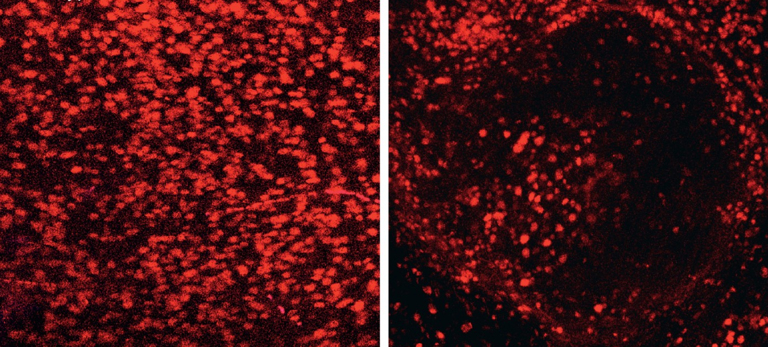Learn about brain health and nootropics to boost brain function
A mouse with 100,000 human neurons in its brain illuminates the enigma of Alzheimer’s

When a person gets older and begins to lose his or her memory, even to forget the names of their loved ones, it is already too late. Alzheimer’s has been quietly destroying the brain for years. If you could open the skull, you would see dead neurons and accumulations of two characteristic proteins: amyloid and tau. The disease threatens to wipe out civilization in the coming decades — there are 10 million new cases of dementia every year — but the scientific community still has no idea what causes it. An international team, including Spanish neuroscientist Amaia Arranz, has introduced 100,000 human neurons into the brains of mice to try to investigate in vivo what happens during the advance of Alzheimer’s disease. The authors have observed how the cells perish and have managed to avoid this neuronal death with a simple oral treatment. Their breakthrough was published Thursday in the journal Science .
Mice are not susceptible to Alzheimer’s, but the researchers genetically modified them to suffer from an accumulation of the amyloid protein. By introducing human neurons into the brains of these rodents, the scientists were able to identify the exact mechanism of neuronal destruction: activation of the MEG3 gene induces necroptosis, a genetically programmed cell death, which is also present in cancer. A drug approved for the treatment of leukemia, ponatinib, and another for melanoma, dabrafenib, prevented neuronal death in these mice. The anti-inflammatory necrosulfonamide achieves the same effect. “There are still no drugs that cure or help alleviate the symptoms of Alzheimer’s disease. This study could help to find therapies that prevent the loss of neuronal cells,” says Arranz of the Achúcarro Basque Center for Neuroscience in Bilbao.
The work was carried out in the laboratory of Belgian biologist Bart De Strooper, of the VIB-KU Leuven Center for Brain & Disease Research (CBD). Arranz and fellow scientist Ira Espuny participated at the CBD in 2017 in the development of the first mouse with human neurons that recreated something similar to Alzheimer’s. The new study has gone a step further by implanting both human and mouse neurons in the rodents. The human neurons immediately showed the hallmarks of the disease: tau and amyloid proteins and cell death. The mouse neurons, on the other hand, remained intact. In the authors’ opinion, these results reveal “a human-specific vulnerability to Alzheimer’s disease .”
The brain of a mouse is the size of a pea, weighs half a gram and contains about 70 million neurons. Arranz explains that the 100,000 implanted human neurons remain in a very specific region. “The mouse brain is still a mouse brain, with a little piece where there are human cells. We are not going to create monsters or Frankensteins,” says the neuroscientist. Her research center is named after Nicolás Achúcarro, a Spanish physician who was working in Munich in Alois Alzheimer’s laboratory when the German neurologist described a new disease in 1906, based on the case of a 50-year-old woman with memory loss issues. More than a century later, mankind continues to ignore the causes of Alzheimer’s disease.
Biologist Estela Area Gómez won last year’s Oskar Fischer Prize for postulating a hypothesis that links neuronal death in Alzheimer’s disease to failures in cholesterol metabolism. In her opinion, the scientific community has been stuck for decades on a false premise: that deposits of amyloid and tau proteins are responsible for dementia. The researcher recalls that the Colombian neurologist Francisco Lopera found two people with an aggressive genetic mutation that condemned them to suffer early Alzheimer’s , but they remained healthy for years due to other protective mutations. “Those patients had a lot of amyloid plaques. In other words, it has been shown that it is not the amyloid plaques that lead to the disease,” says Gómez, of the Margarita Salas Center for Biological Research in Madrid.
Gómez is skeptical about the conclusions of the new study, in which she did not participate. “These mice, at a technical level, are wonderful, but I have serious doubts as to whether they really reflect what happens in humans,” she says. “It’s like if you want to make a mouse that models a covid infection and, instead of infecting it with the cause — the coronavirus — you decide you’re just going to induce an increase in fever. What you’re doing is mirroring the symptoms of the disease in the mouse, but not the disease per se.”
Two years ago, the United States authorized aducanumab , touted as the first drug to attack the presumed causes of Alzheimer’s disease. The drug — developed by the U.S. pharmaceutical company Biogen and priced at about $42,500 euros per patient per year — eliminates the amyloid proteins that accumulate between neurons. The European Medicines Agency, however, has refused to approve aducanumab because it found no evidence of its efficacy.
“My question is how long are we going to continue investing all our efforts in eliminating amyloid plaques, when we are seeing that there are people with three, four or five times more amyloid plaques than an Alzheimer’s patient and they have no cognitive defects,” says Gómez. The biologist recalls that carrying the APOE4 gene multiplies the risk of suffering from Alzheimer’s and is related to cholesterol metabolism. “Nature is shouting at us that the failure of cholesterol metabolism in neurons is one of the causes, if not the main cause, of Alzheimer’s.”
De Strooper founded the prestigious Dementia Research Institute in the UK in 2016, where he directed the work of over 800 scientists until last year. The Belgian is one of the world’s leading experts on Alzheimer’s. His study suggests that understanding the molecular intricacies of neuronal resistance in mice to the disease will illuminate the path to protecting the human brain.
Sign up for our weekly newsletter to get more English-language news coverage from EL PAÍS USA Edition